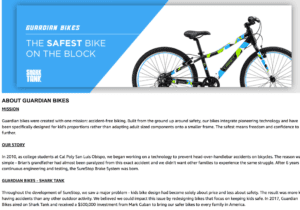While Amazon.com Inc.’s marketplace offers merchants on the platform an opportunity to drive additional revenue and acquire new customers, there’s a big drawback for many brands: Are Amazon’s customers noticing their brands when purchasing from them on Amazon.com?
Recently, Amazon has rolled out some new features for brand building on the platform that may help marketplace sellers. Brian Riley, CEO of Guardian Bike Co., and Andrew Jacobs, CEO of JAM Paper & Envelope, spoke at the Internet Retailer Conference and Exhibition at RetailX in Chicago in June about best practices for brands on Amazon.
Be concerned with reputation.
Recognize that to acquire new customers through Amazon’s marketplace, retailers must have a strong seller rating and product reviews. That’s how shoppers trust a brand—one they likely haven’t heard of before—and convert into a buyer. Jacobs advises third-party marketplace sellers on Amazon to solicit reviews by asking buyers for feedback.
Sell the brand, not just the product.
Merchants should know the brand mission and integrate it within every product they sell, Riley says. For Guardian Bikes, that means reminding potential customers of the brand’s core value: a promise of safety while riding their bikes. For JAM Paper, that means ensuring no product leaves its warehouse without packaging that has its logo on it. JAM Paper’s office supplies products typically don’t have a logo on the actual product, which makes it more important for the packaging to have the logo, Jacobs says.
Use the branding tools Amazon offers.
Marketplace sellers who are part of Amazon’s Brand Registry—a program that provides sellers that have a registered trademark with tools to control their brand’s representation on Amazon, including control over all the brand’s product listings—can use videos, can have a branded storefront and can use Enhanced Brand Content.
Enhanced Brand Content enables a brand to include a “unique brand story, enhanced images and text placements” in describing its products, Amazon says in its promotional materials. When a consumer is on a page with Enhanced Brand Content, she’ll see additional information about the product or the company as a whole on the page, such as a brand’s mission statement and detailed graphics describing the product.
Retailers should use the extra space to show their brand. For example, Guardian Bike’s product page includes details about the company’s mission, the story behind how the company began and the company’s appearance on the hit TV show “Shark Tank.”

Amazon also offers sellers enrolled in Brand Registry the option to create a branded store: a custom page with a unique URL (www.amazon.com/brand) that sellers can use to list an assortment of products, showcase multimedia content and tell a brand’s story. Retailers should have branded titles and images. “Amazon is offering it, so we’re going to use it,” Jacobs says. “We use it as a branding opportunity, so we made the page look as professional as we could so we present a trustworthy and nice-looking brand,” he says.
Branded product titles and images.
Every product title should include the brand’s name, both speakers said, because the title is the first thing a consumer sees and it’s the first time to showcase the brand. For example, a product page for JAM Paper’s envelopes has the title “Jam Paper A7 Colored Invitation Envelopes.”
Additionally, retailers should include the brand’s logo in videos and images. In a video showing a 360-degree view of a plastic expansion envelope, JAM Paper’s logo is in the bottom right-hand corner, for example.
Maintain consistency on all marketplaces.
Make sure the copy, icons and images used on product pages are the same across website, on Amazon and on all other channels. This enhances the professionalism of the brand.
Keep products in stock.
Amazon penalizes the brand if products run out of stock. Riley and Jacobs suggest analyzing historical sales and inventory on hand on a daily basis. If the stock a brand sent to Amazon’s fulfillment centers for its fulfillment program Fulfillment by Amazon runs out, then the retailer should fulfill the item itself, Jacobs said. FBA allows sellers to offer products to Prime customers expecting free two-day shipping.
Amazon is the No. 1 retailer in the 2019 Internet Retailer Top 1000.
Favorite